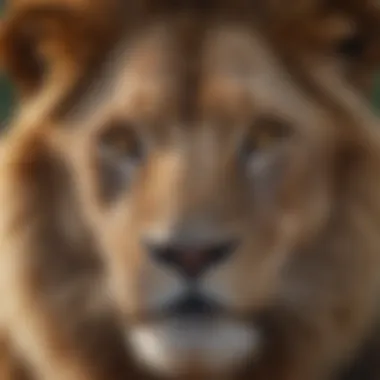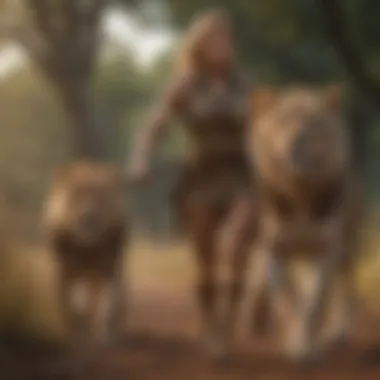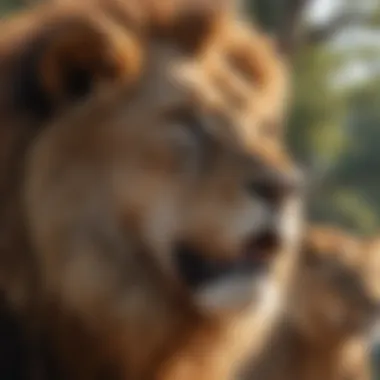Unveiling the Majestic Lion: A Comprehensive Insight into the King of the Jungle


Nature Topic Overview
The majestic lion, also known as the King of the Jungle, commands attention with its awe-inspiring presence. In this in-depth exploration, we will unravel the mysteries surrounding this regal feline. From its striking physical features to its intricate behaviors, we will navigate the captivating world of the lion.
Fun Facts and Trivia
As we venture into the realm of lions, let's uncover some fascinating tidbits that will intrigue young minds. Did you know that lions can sleep up to 20 hours a day? This interesting fact not only showcases their lazy reputation but also highlights their efficient energy conservation strategy. Furthermore, lions are social creatures, often forming strong bonds within their pride. These engaging facts provide a glimpse into the intriguing life of these majestic beasts.
Wildlife Explorations
Delving deeper into the ecosystem, we will explore the intertwined relationships within the lion's habitat. Lions play a vital role in maintaining the balance of their environment as top predators. Additionally, we will learn about other species that coexist with lions, shedding light on the biodiversity of their ecosystem. Engaging quizzes and puzzles will immerse young explorers in the world of wildlife, fostering a deeper appreciation for nature's interconnected beauty.
Environmental Awareness
The conversation surrounding conservation and sustainability is crucial to protecting these magnificent creatures. By understanding the importance of preserving lion populations and their habitats, children can actively contribute to wildlife conservation. Simple tips and practical steps will empower young readers to make a positive impact on the environment, nurturing a sense of responsibility towards nature.
DIY Nature Activities
For hands-on learning experiences, we will offer a variety of engaging activities for children to try at home. From creating lion-inspired crafts to embarking on outdoor explorations, young minds will have the opportunity to deepen their connection with nature. Step-by-step guides will facilitate the creation of nature-inspired projects, encouraging creativity and fostering a sense of curiosity about the world around us.
Introduction to the Lion


In this article, we embark on an enlightening journey into the world of the lion, a majestic and powerful creature that holds a significant place in the ecosystem. Understanding the lion is crucial for appreciating the intricate balance of nature and the role of top predators. By delving into the origins and evolution of lions, we gain a profound insight into how these magnificent creatures have adapted over time to thrive in various environments.
Origins and Evolution
The ancestral lineage of lions
When exploring the ancestral lineage of lions, we uncover a rich history of how these felines have evolved to become the apex predators we recognize today. The evolutionary path of lions sheds light on their genetic makeup, behavioral traits, and physical characteristics, offering valuable insights into their survival strategies. By understanding the ancestral lineage of lions, we can appreciate the connections between past and present, illuminating the reasons behind their distinctive features and adaptive behaviors.
Physical Characteristics
The distinctive mane of male lions
One of the most iconic features of male lions is their distinctive mane, which serves multiple purposes beyond just visual appeal. The mane plays a crucial role in signaling dominance within a pride, deterring rival males, and protecting the neck during intense combat. Examining the intricate details of the mane provides a glimpse into the complexities of social hierarchy and mating dynamics among lions. By dissecting the significance of the mane, we unravel the layers of symbolism and functionality that make it a vital aspect of a male lion's identity.
Adaptations for hunting and survival
In the realm of hunting and survival, lions have developed remarkable adaptations that enable them to thrive in challenging environments. From their keen sense of sight and stealthy movements to their powerful jaws and muscular physique, every aspect of a lion's physical traits is finely tuned for the art of predation. Exploring these adaptations offers a deeper understanding of how lions have honed their skills over generations, adapting to diverse landscapes and prey behaviors. By analyzing the adaptations for hunting and survival, we gain a profound respect for the evolutionary prowess of these master hunters.
Behavioral Insights
The section on Behavioral Insights delves into the intricate behaviors of lions in their natural habitat, shedding light on how these behaviors contribute to their survival and dominance in the animal kingdom. By examining their hunting strategies, social dynamics, and communication methods, readers can gain a profound understanding of the lion's behavior and its significance. Understanding these insights is crucial for appreciating the complexities of lion society and ecology, offering valuable knowledge for wildlife enthusiasts and researchers alike.


Coordinated Hunting Techniques
Coordinated hunting techniques are a pivotal aspect of a lion's hunting strategy, where members of the pride collaborate seamlessly to secure a successful hunt. This coordinated approach involves strategic positioning, synchronized movements, and effective communication among the pride members. The key characteristic of coordinated hunting lies in its ability to enhance the efficiency and success rate of hunts, ensuring a higher chance of capturing prey. Despite its advantages, this technique requires precise coordination and cooperation among lions, making it a demanding yet rewarding choice for hunting in the wild.
Ambush and Chase Tactics
Ambush and chase tactics represent another essential component of a lion's hunting repertoire, allowing them to capitalize on their speed and agility during pursuits. Lions often employ ambush tactics to surprise their prey, followed by swift chases to capitalize on their prey's vulnerability. The key characteristic of this strategy lies in its swift and decisive nature, enabling lions to outmaneuver their targets with calculated precision. While ambush and chase tactics can yield quick results, they also require a high level of physical exertion and strategic planning, making them a strategic yet resource-intensive approach to hunting.
Social Structure
Exploring the social structure of lions reveals the complex hierarchy and interactions within a pride, showcasing the roles and relationships that define lion society. By examining the dynamics of a lion pride and the crucial role of lionesses in hunting, readers can grasp the intricate social norms and behaviors that govern these majestic creatures. Understanding the social structure of lions offers unique insights into their cooperative nature and familial bonds, shedding light on the importance of unity and collaboration in their daily lives.
The Dynamics of a Lion Pride
The dynamics of a lion pride revolve around hierarchical relationships, territorial defense, and cooperative hunting strategies that ensure the pride's survival and success. Each member plays a specific role within the pride, from the dominant male and his lionesses to the younger offspring learning essential skills for adulthood. The key characteristic of lion pride dynamics lies in their cohesion and collaboration, where each member contributes to the collective well-being of the group. While this social structure fosters teamwork and mutual support, it also entails challenges such as competition for resources and protection within the pride.
Role of Lionesses in Hunting
The role of lionesses in hunting is paramount to the pride's sustenance, as these female lions exhibit remarkable hunting prowess and strategic coordination during hunts. Lionesses often take the lead in hunting expeditions, showcasing speed, agility, and tactical planning to secure prey for the pride. The key characteristic of lionesses' hunting role lies in their efficiency and skill in capturing prey, essential for sustaining the pride's nutritional needs. While their hunting contributions are indispensable, lionesses also face risks and challenges in navigating dangerous terrain and confronting formidable prey, underscoring the resilience and determination required for successful hunting.
Ecological Significance


The section on Ecological Significance delves deep into the crucial role that lions play in their ecosystem. These majestic creatures hold the prestigious title of being top predators, which significantly impacts the balance of the ecosystem. As apex predators, lions regulate the population of herbivores, preventing overgrazing and maintaining a harmonious coexistence within the food chain. Their presence ensures biodiversity and the health of the ecosystem as a whole, making them vital components of the animal kingdom.
Top Predator Status
Impact on ecosystem balance
The Impact on ecosystem balance that lions possess is truly remarkable. By controlling the population of herbivores such as zebras and antelopes, lions help maintain a healthy balance in the food chain. This prevents herbivores from overexploiting vegetation, which in turn protects the grasslands and forests from degradation. The regulation of herbivore populations by lions is crucial for preserving the ecological integrity of habitats and promoting species diversity.
Conservation Challenges
Threats to Lion Populations
The Threats to lion populations are multifaceted and pose significant challenges to their survival. Factors such as habitat loss, human-wildlife conflict, poaching, and climate change are putting immense pressure on lion populations across their range. Habitat fragmentation and degradation due to human activities are leading causes of decline in lion numbers, forcing them into smaller and isolated areas where they are more vulnerable to threats.
Conservation efforts and initiatives
Efforts to conserve lions are underway, aiming to address the various threats faced by these iconic predators. Conservation initiatives focus on habitat protection, anti-poaching measures, community engagement, and scientific research to ensure the long-term survival of lion populations. Collaborative approaches involving local communities, governments, NGOs, and international organizations are essential for implementing effective conservation strategies to safeguard lions and their habitats for future generations.
Conclusion
In unraveling the enigmatic world of the lion, it becomes apparent that the importance of lion conservation is paramount. Preserving these majestic creatures for future generations is not just a moral obligation but a crucial step towards maintaining ecosystem balance. As apex predators, lions play a pivotal role in regulating prey populations, which in turn has cascading effects on the entire ecosystem. The conservation of lions ensures the preservation of biodiversity and the delicate web of life in which they hold a critical position. Without concerted conservation efforts, the loss of lions could lead to a destabilization of ecosystems, affecting not only wildlife but also human communities reliant on ecosystem services provided by these magnificent predators.
Importance of Lion Conservation
Preserving these Majestic Creatures for Future Generations
Delving into the realm of preserving these majestic creatures for future generations exposes a multifaceted approach to safeguarding lion populations. The intrinsic value of lions lies not only in their charismatic appeal but also in their irreplaceable ecological significance. By conserving lions, we uphold intrinsic biodiversity, paving the way for a thriving natural world for generations to come. The conservation of lions is a testament to our commitment to coexist harmoniously with nature, recognizing their existence as a barometer of ecosystem health. This proactive stance not only safeguards the future of lions but also symbolizes our dedication to preserving the intricate tapestry of life that encompasses these iconic predators in a delicate embrace. Adopting sustainable practices and promoting cohabitation with lions solidifies our stance as stewards of the environment, advocating for the protection and perpetuation of these majestic creatures in a rapidly changing world.







